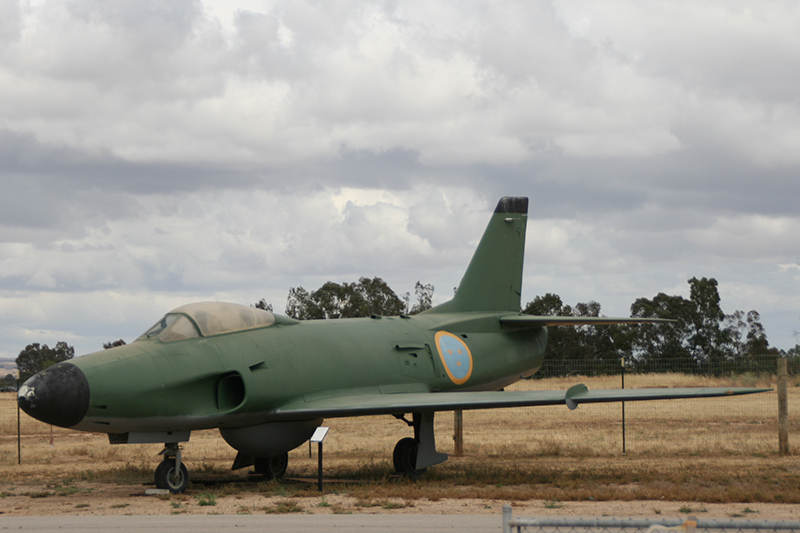Specifications
| Manufacturer: | Saab | |
|---|---|---|
| Year/Model: | 1958 A-32A Lansen | |
| S/N: | 32284 | |
| Tail Number: | N4767R | |
| Power Plant: | RM5A2 (=RR Avon Mk.21/21A) with Swedish afterburner | |
| Wingspan: | 42 feet 9 inches | |
| Length: | 48 feet 1 inch | |
| Height: | 15 feet 7 inches | |
| Gross Weight: | 30,000 pounds | |
| Maximum Speed: | 692 MPH | |
| Maximum Range: | 2,000 Statute miles with external tanks | |
| Service Ceiling: | 49,200 feet | |
| Crew: | 2 | |
| Status: | Static Display | |
| Owner: | Estrella Warbirds Museum | |
In Flight
History
Estrella Warbirds Museum acquired the A-32A aircraft in September of 2009, for restoration to a static display status. It was moved from Mojave to Paso Robles, having been dismantled. Approximately the same length as an A7, the rear half could easily fit onto the transport trailer. Next step: Reassembly and prep for a new paint coatings. Manufactured by SAAB of Sweden (yes, the same company which produced fine automobiles). During the past 30 years, Estrella Warbirds Museum has been generously supported by volunteers who dedicate their talents and energies in the restoration of military aircraft. This one arrived in bits and pieces!
The initial production version of the Lansen was the tandem-seat "A32A" dedicated attack variant, which entered service in 1955. By 1957, twelve squadrons had been equipped with the A32A for the Swedish Air Force.
Military Aircraft Restorations Corporation donated two SAAB Lansens to the United States Airpower Museum, SAAB construction numbers 32209, and 32284. In September of 2009, Estrella Warbirds Museum acquired the 32284 aircraft. The A32A were armed with four Swedish-built Hispano Mark V 20 millimeter cannon fitted in the nose, with 180 rounds per gun. The gun ports were sealed by shutters that popped open automatically when the pilot disengaged the weapon safety. A pair of small plates under the nose prevented the ejected casings from ingestion by the engine intakes. The casings did strike the centerline external fuel tank, and so a neoprene plastic shell protected the nose of the fuel tank. The radar used in the A32A was designated PS-431/A and was of French design, built in Sweden. These aircraft operated in groups, and as an economy measure only about 25% of them were given radars. It also seems like not all aircraft had a navigator on board, so it's likely that everybody just followed the boss.
In Swedish service they replaced Saab B/T 18 bombers, foremost in the anti-ship/invasion role, so the main weapon was the Saab 304 rocket powered anti-ship missile with an estimated range of 20 km in the early versions, other common loads were unguided rockets. The Lansen was an effective strike aircraft, providing a stable platform for cannon and rocket attacks. A total of 287 A32As were delivered from 1955 through 1958, The A32A was followed in production by the "J32B", a tandem-seat all-weather fighter variant. The initial J32B first flew on 7 January 1957, and the type went into squadron service in July 1958.
The Swedish air force desperately wanted a Spitfire PR.XIX (as all Swedish ones had been scrapped). One was found in Canada, to finance its purchase one DC-3, one Skyraider, one Hawker Hunter, two Lansens and one Lansen fuselage were sold, the Lansens to Military Aircraft Restoration Corporation. The Lansens were flown to USA via Scotland, Iceland, Greenland and Canada in around ten flights (around because once oxygen couldn't be filled at one airport in Scotland so it had to be done at another and they had slightly different performances, 32284 was faster, could fly higher and had 6 min longer endurance than 32120) sometimes with waiting times of weeks.
First 32120 / FC 20 / N4767R, then 32284 / FC 24 / N4432V (FC = Försökscentralen, the establishment for flying trials) which had a contrasting black and white scheme. The airframe example, 32209 / FC 29 / N5468X, wasn't shipped to the USA, as it was airworthy and FFA had planned on shipping a Lansen wing to USA for wind tunnel testing. As it happened the testing was performed not in a wind tunnel but during the delivery flight between Septiles and Montreal in the Canadian Armed Forces' exercise area. It then spent two years at Langley and then flown to Los Angeles and was the only Lansen which was used in USA, then by Mach Two Flight Services Inc.
In 1990 all three were put up for sale, but weren't sold and were put in storage in the Mojave desert. In 2002, two, N5468X and N4432V, were donated to the United States Airpower Museum, which planned on putting one of them in airworthy condition.









